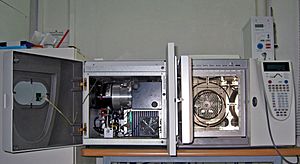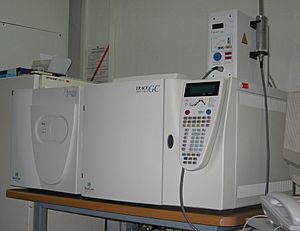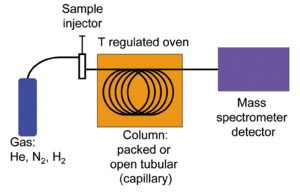Gas chromatography–mass spectrometry facts for kids
Gas chromatography–mass spectrometry (GC-MS) combines the features of gas-liquid chromatography (GC) and mass spectrometry (MS). This makes it possible to identify different substances within a test sample. GC-MS has many uses include fire investigation, environmental analysis and explosives investigation. It can also be used to identify unknown samples. GC-MS can also be used in airport security to detect substances in luggage or on human beings. Additionally, GC-MS can identify trace elements in deteriorated materials, even after the sample fell apart so much that other tests cannot work.
GC-MS is the best way for forensic experts to identify substances because it is a specific test. A specific test positively identifies the actual presence of a particular substance in a given sample. A non-specific test only says that categories of substances are in the sample. Although a non-specific test could statistically suggest the identity of the substance, this could lead to false positive identification.
Contents
History
The first research papers on gas-liquid chromatography were published in 1950. Chemists used different detectors to see that compounds were flowing out of the end of the chromatograph. Most of the detectors destroyed the compounds, because they burned them or ioned them. These detectors left chemists guessing the exact identity of each compound in the sample. In the 1950s, Roland Gohlke and Fred McLafferty developed a new combined machine. They used a mass spectrometer as the detector in gas chromatography. These early devices were big, fragile, and originally limited to laboratory settings.
The design was complex. The time interval between different compounds flowing out of the chromatograph was hard to control. So, the mass spectrometer had to finish working on one compound before the next one flowed out of the chromatograph. In the early models, the measurements from the mass spectrometer was recorded on graph paper. Highly-trained chemists studied the patterns of peaks to identify each compound. By the 1970s, analog-to-digital converters were added to mass spectrometers. This allowed computers to store and to interpret the results. As computers grew faster and smaller, GC-MS became faster and spread from laboratories into every day life. Today, computerized GC-MS instruments are widely used in environmental monitoring of water, air, and soil. It is also used in the regulation of agriculture, food safety and in the discovery and production of medicine.
The development of small computers has helped in the simplification of GC-MS machines. It also greatly reduced the amount of time it takes to analyze a sample. Electronic Associates, Inc. (EAI) was a leading U.S. supplier of analog computers. In 1964, EAI began development of a computer-controlled mass spectrometer under the direction of Robert E. Finnigan. By 1966, over 500 gas-analyzer instruments were sold. In 1967, the Finnigan Instrument Corporation (FIC) was formed. In early 1968, delivered the first prototype quadrapole GC-MS instruments to Stanford and Purdue University. FIC was eventually renamed Finnigan Corporation and went on to establish itself as the worldwide leader in GC-MS systems.
Basic operation
GC-MS can find all of the compounds mixed together in a sample object. The operator dissolves the sample in a liquid. The operator then injects the liquid into a stream of gas. (Helium, Hydrogen or Nitrogen gas are used most often.) The gas flows through a tube with a special coating. Because each compound in the sample sticks to the coating in a different way, each compound comes out of the tube at a different time. So the coating is used to separate each compound that was mixed together in the sample. As each compound comes out at the end of the tube, it is ionized and gets an electric charge. Most compounds break apart when they are ionized. The different pieces fly under a magnet which separates the pieces based on their weight and charge. A computer then measures all of the pieces of each compound. By comparing the measurements against a computer library of known compounds, the computer makes a list of the names of all of the compounds in the sample. The computer can also tell how much of each compound was in the sample.
Instrumentation

The GC-MS is made up of two major building blocks: the gas chromatograph and the mass spectrometer. The gas chromatograph uses a capillary column which depends on the column's dimensions (length, diameter, film thickness) as well as the phase properties (e.g. 5% phenyl polysiloxane). The difference in the chemical properties between different molecules in a mixture will separate the molecules as the sample travels the length of the column. The molecules take different amounts of time (called the retention time) to come out of (elute from) the gas chromatograph. This allows the mass spectrometer downstream to capture, ionize, accelerate, deflect, and detect the ionized molecules separately. The mass spectrometer does this by breaking each molecule into ionized fragments and detecting these fragments using their mass to charge ratio.
These two machines, used together, allow a much finer precision of substance identification than either unit used separately. It is not possible to make an accurate identification of a particular molecule by gas chromatography or mass spectrometry alone. The mass spectrometry process normally requires a very pure sample. In the past, gas chromatography use other detectors such as a Flame Ionization Detector. These detectors cannot separate different molecules that happen to take the same amount of time to travel through the column. (When two different molecules have the same retention time they are said to "co-elute".) The co-eluting molecules will confuse the computer programs that are reading a single mass spectrum for both molecules.
Sometimes two different molecules can also have a similar pattern of ionized fragments in a mass spectrometer (mass spectrum). Combining the two processes reduces the possibility of error. It is extremely unlikely that two different molecules will behave in the same way in both a gas chromatograph and a mass spectrometer. Therefore, if a mass spectrum matches the analyte of interest, the retention time of that spectrum can be checked against a characteristic GC retention time to increased confidence that the analyte is in the sample.
Types of mass spectrometer detectors
The most common type of MS associated with a GC is the quadrupole mass spectrometer. Hewlett-Packard (now Agilent) markets it under trade name "Mass Selective Detector" (MSD). Another relatively common detector is the ion trap mass spectrometer. Additionally one may find a magnetic sector mass spectrometer. However these particular instruments are expensive and bulky and not typically found in high-throughput service laboratories. Other detectors are used such as time of flight (TOF), tandem quadrupoles (MS-MS) (see below), or in the case of an ion trap MSn. The n indicates the number mass spectrometry stages.
Applications
Environmental monitoring and cleanup
Many chemists believe that GC-MS is the best tool for monitoring organic pollutants in the environment. The cost of GC-MS equipment has decreased a lot. The reliability of GC-MS has increased at the same time. Both improvements have increased use in environmental studies. Some compounds, such as certain pesticides and herbicides, cannot be identified by GS-MS. They are too similar to other related compounds. But for most organic analysis of environmental samples, including many major classes of pesticides, GC-MS is very sensitive and effective.
Law enforcement
GC-MS is used for detection of illegal narcotics, and may eventually replace drug-sniffing dogs. It is also commonly used in forensic toxicology. It helps to find drugs and/or poisons in biological specimens taken from suspects, victims, or a dead body.
Security
After the September 11, 2001 terrorist attacks, explosive detection systems have become a part of all US airports. These systems run on a host of technologies, many of them based on GC-MS. There are only three manufacturers certified by the FAA to provide these systems. The first is Thermo Detection (formerly Thermedics), which produces the EGIS, a GC-MS-based line of explosives detectors. The second is Barringer Technologies, which is now owned by Smith's Detection Systems. The third is Ion Track Instruments (part of General Electric Infrastructure Security Systems).
Astrochemistry
Several GC-MS have left earth. Two went to Mars in the Viking program. Venera 11 and 12 and Pioneer Venus analysed the atmosphere of Venus with GC-MS. The Huygens probe of the Cassini-Huygens mission landed one GC-MS on Saturn's largest moon, Titan. The material in the comet 67P/Churyumov-Gerasimenko will be analysed by the Rosetta mission with a chiral GC-MS in 2014.
Medicine
GC-MS are used in newborn screening tests. These tests can find dozens of congenital metabolic diseases (also known as Inborn error of metabolism). GC-MS can determine compounds in urine even in very small amounts. These compounds are normally not present but appear in individuals suffering with metabolic disorders. This is becoming a common way to diagnose IEM for earlier diagnosis and beginning of treatment. This eventually leads to a better outcome. It is now possible to test a newborn for over 100 genetic metabolic disorders by a urine test at birth based on GC-MS.
In combination with isotopic labeling of metabolic compounds, the GC-MS is used for determining metabolic activity. Most applications are based on the use of 13C as the labeling and the measurement of 13C-12C ratios with an isotope ratio mass spectrometer (IRMS). A IRMS is an mass spectrometer with a detector designed to measure a few select ions and return values as ratios.
Images for kids




